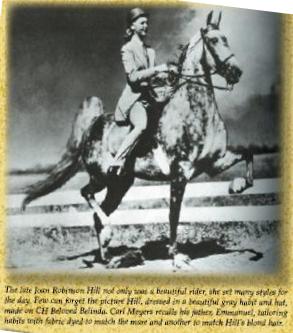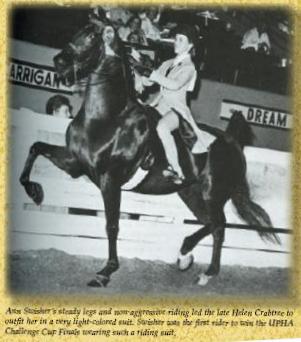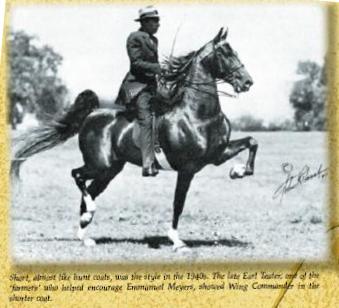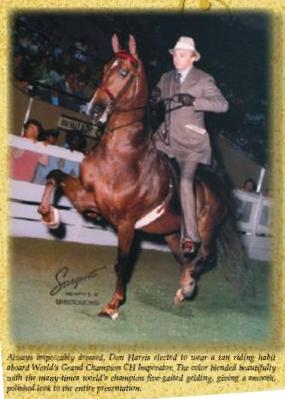|
Clothes and accessories make the
man (and woman.) That saying holds true in many walks of life, few more than when showing a Saddle Horse. It seems so simple:
buy a riding habit, fix your hair and makeup and show your horse. Not so, nor does what ‘worked’ years ago apply
to today.
Granted, a
lot depends on where you or your child wants to go. It’s simple in the beginning: a pair of jods, usually off the rack
or by mail, a pair of boots, shirt and vest and tie, plus a riding helmet, suits most academy exhibitors. But what, where
and why? And how did we get where we are, anyway?
Riders
have gone through many ‘fashion stages.’ British cavalrymen adapted the loose-fitting, blousy pants worn by natives
of India during the British colonial period in that country. The jodhpur, named for the region where the style originated, offered greater comfort for riders
in those hot climates. Early saddle seat riders rode in traditional English hunt seat attire, with flared breeches and high
boots. Later, riders wore a cuffed or ‘pegged’ jodhpur
without calf boots as hunt attire. Ladies rode side saddle, then adopted a split skirt when first riding astride.
Current fashion
can be traced back to Carl Myers’s grandfather Emmanuel Myers of Lexington, Ky. Myers’s army surplus store became
the center for Saddle Horse riders after World War I.
“Granddad
carried boots and different things farmers used around here,” Carl Meyers said. “That’s how he got introduced
to the Saddle Horse guys such as Earl Teater and the Bradshaws. They got him involved with designing riding apparel.”
Emmanuel Meyers
was the first to design the ‘jodhpur’ as we know it today.
“The
straighter-legged pants which pulled down over a rider’s boot presents a cleaner, sleeker look for the American Saddlebred,”
Carl Meyers explained. “It was more a uniform than fashion-oriented. Saddle seat riders showed in Kentucky
jodhpurs with hunt coats, later adopting longer coats. Granddad was the first to put inverted pleats in the back of riding
coats.”
Meyers explained
that factories that used to produce custom riding apparel closed down those lines to make uniforms during World War II. In
the late 1940s and ’50s, ‘fashionable’ riding clothing came into play. By then, Melvin Meyers had joined
the family company.
Meyers recalled
his father dressing the late Joan Robinson Hill, and getting involved with what he called “the Texas
group. That’s when fashion really started coming about. Joan had things dyed to match her horses and one to match her
hair.”
The picture
of the beautiful equestrienne and elegant gray mare, Beloved Belinda, is one Saddle Horse fans of the mid and late-1950s still
remember. The pair dominated the amateur five-gaited division during that time, tying champion or reserve at the World’s
Championship Horse Show from 1953 through 1957.

The late Joan Robinson Hill not only was a beautiful rider, she set many styles for the day. Few
can forget the picture Hill, dressed in a beautiful gray habit and hat, made on CH Beloved Belinda. Carl Meyers recalls his
father, Emmanuel, tailoring habits with fabric dyed to match the mare and another to match Hill’s blond hair.
The 1960s
saw more fashion changes. “The first thing was a white coat at night. And that was the era that brocades started coming
out. They made a big hit with Julianne [Schmutz] and that group,” Carl Meyers recalled.
Solid suits
with different linings, some in paisleys and other prints and some in a contrasting color, became popular. The most prominent
of these that helped set a trend was Mitchell Clark’s navy blue suit with a red lining he wore while showing CH Sky
Watch to the Five-Gaited World’s Grand Championship. Don Harris helped popularize the tan suit for performance riding
when he showed CH Imperator.
The late Helen
K. Crabtree helped set the style for equitation riders. In 1976, Ann Swisher won the UPHA Challenge Cup Finals wearing a very
light-colored suit. Marsha Shepard (of Marsha de Arriaga) recalled speaking with Mrs. Crabtree about outfitting an equitation
rider.

Ann Swisher’s steady legs and non-aggressive riding led the late Helen Crabtree to outfit
her in a very light-colored suit. Swisher was the first rider to win the UPHA Challenge Cup Finals wearing such a riding suit.
“She
told me years ago that she put Ann Swisher in a light suit for a very good reason. She was a very quiet rider, almost too
quiet and rode a very smooth horse. She didn’t look aggressive enough in the ring. When Swisher wore the light suit,
you couldn’t take your eyes off her,” Shepard said. “Helen did this for totally different reasons than many
comprehend now. She had an artist’s as well as an equestrian’s eye.”
“Helen
was the matriarch of all that,” Meyers said. “She already had done some with gray suits,” Meyers said, admitting
that Mrs. Crabtree intimidated him. “She was so concerned about the fit, how she wanted the legs to look. She went for
an appropriate length – long enough, about four inches before the finger tips. Today they are at the knee cap.”
Meyers says
he interpreted ‘that look’ for Lillian Shively. “She has a wonderful style and color sense. She has made
another whole change in equitation from what I specialized in during those days.”
Fashion has
followed success in more arenas than Saddle Horses. Shepard spoke of a trend in the jumping world.
“I once
asked George [Morris] why the cut of his hunt coat was so short. He had a weak upper body and long legs and therefore cut
his jacket short,” Shepard said of the Show Jumping Hall of Fame member. “Others copied his style after he won
the McClay Medal [in 1952.] If riders had thunder thighs, they still wore short jackets.”

Short, almost like hunt coats, was the style in the 1940s. The late Earl Teater, one of the ‘farmers’
who helped encourage Emmanuel Meyers, showed Wing Commander in the shorter coat.
The late Nona
Rutland, who trained such champion riders as the late Joan Robinson Hill, Zel Corkern and Barbe Smith at Audubon Stables in
New
Orleans, and Annie Lawson Cowgill wrote the ‘book’ on horsemanship in 1952. They were assisted
by Mrs. Helen K. Crabtree of Colliersville, Tenn.
The 16-page A Standard for Three and Five-Gaited Horsemanship set forth some very definite recommendations on
appointments. Informal dress recommendations included wearing tweed, gabardine, linen, salt sack, check, plaid or solid color
coats with pants to blend, contrast or match the coat. Kentucky
jods, peg or frontier style were acceptable. A small, single flower boutonniere and handkerchief were worn in the left side
breast pocket. In discussing semi-formal and formal attire, she stated that “coats should be long enough to properly
cover the seat.”

Always impeccably dressed, Don Harris elected to wear a tan riding habit aboard World’s Grand
Champion CH Imperator. The color blended beautifully with the many-times world’s champion five-gaited gelding, giving
a smooth, polished look to the entire presentation.
|



